|
|
|
Sort Order |
|
|
|
Items / Page
|
|
|
|
|
|
|
| Srl | Item |
| 1 |
ID:
098403
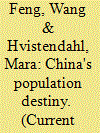

|
|
|
|
|
| Publication |
2010.
|
| Summary/Abstract |
China's population is likely to peak less than 15 years from now, below a maximum of 1.4 billion. After that will come a prolonged, even indefinite, population decline and a period of accelerated aging.
|
|
|
|
|
|
|
|
|
|
|
|
|
|
|
|
| 2 |
ID:
137809
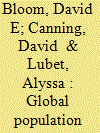

|
|
|
|
|
| Summary/Abstract |
The rapid aging of populations around the world presents an unprecedented set of challenges: shifting disease burden, increased expenditure on health and long-term care, labor-force shortages, dissaving, and potential problems with old-age income security. We view longer life spans, particularly longer healthy life spans, as an enormous gain for human welfare. The challenges come from the fact that our current institutional and social arrangements are unsuited for aging populations and shifting demographics; our proposed solution is therefore to change our institutions and social arrangements. The first section of this essay provides a statistical overview of global population aging and its contributing factors. The second section outlines some of the major challenges associated with widespread population aging. Finally, the third section of the essay describes various responses to these challenges, both current and prospective, facing individuals, businesses, institutions, and governments.
|
|
|
|
|
|
|
|
|
|
|
|
|
|
|
|
| 3 |
ID:
110345
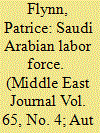

|
|
|
|
|
| Publication |
2011.
|
| Summary/Abstract |
This article provides a framework from which to explore the Saudi labor force, drawing from the national labor market model designed by the US Department of Labor in the 1940s and applied to the Saudi workforce using data from the Saudi Arabian Central Department of Statistics and Information. The findings provide the first comprehensive statistical portrait of the Saudi labor force and a baseline from which to systematically track expected increases in labor force participation, especially among Saudi women and youth, in the decades to come.
|
|
|
|
|
|
|
|
|
|
|
|
|
|
|
|
| 4 |
ID:
090109
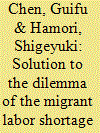

|
|
|
|
|
| Publication |
2009.
|
| Summary/Abstract |
Since 2003, China's labor market has been facing two coexisting crises: a rural labor surplus and a severe shortage of migrant labor. Using data from the 2000 China Health and Nutrition Survey questionnaire, which covers 288 villages in 36 counties, this paper attempts to find a solution to this dilemma. Specifically, a multinomial logit model, a Mincer-type model and a probit model are applied to examine the effect of educational level on the employment choices for rural laborers, and on the wages and the employment status of migrants. Based on the results of our analysis, we propose the implementation of policy aimed at increasing the educational level of rural dwellers, in conjunction with other policies to eliminate all artificial barriers, to facilitate the migration of rural laborers.
|
|
|
|
|
|
|
|
|
|
|
|
|
|
|
|
| 5 |
ID:
105433


|
|
|
|
|
| Publication |
2011.
|
| Summary/Abstract |
The article provides an overview of the changes that have taken place in the kibbutzim since 1990 and assesses their significance. Between 1995 and 2010, most kibbutzim abandoned their traditional practice of sharing income "from each according to ability, to each according to need", and began paying differential salaries to members on the basis of the market value of their work. Academics, the kibbutz movement, and the Israeli government agree that kibbutzim that pay differential salaries are still kibbutzim, but they see them as kibbutzim of a new type, the so-called "renewed" kibbutz. More than a third of kibbutz members now work outside their kibbutz, while more than half of the labor performed inside the kibbutzim is now done by nonmembers. The number of kibbutz members has stagnated for decades, while nonmembers are the only portion of the kibbutz population that shows dynamic growth. So far, these developments have strained, but not yet terminated, the historic identities of these organizations as cooperatives, as communes, and as kibbutzim. More changes, however, are on the way. Both in renewed kibbutzim and the kibbutzim that remain "collective", most members now want to become owners of their homes and of individual capital stakes in the economic ventures of their kibbutzim, and many have begun to talk about transforming their kibbutz into a moshav or a municipality.
|
|
|
|
|
|
|
|
|
|
|
|
|
|
|
|
| 6 |
ID:
110247
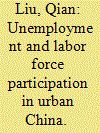

|
|
|
|
|
| Publication |
2012.
|
| Summary/Abstract |
This paper serves to document and analyze the employment and the labor market changes in urban China since the late 1980s. High and sustained GDP growth rates in China have paradoxically been accompanied by increasing unemployment rates and decreasing labor force participation rates. Using national representative micro data, estimations from logit models show that age, education, communist-party membership and marital status are significantly associated with participation in the labor force and employment opportunities, and the impacts of education and party membership have increased over time. An extension of the Blinder-Oaxaca decomposition finds little of the observed male-female differentials attributable to differences in characteristics such as age or education but to coefficient effects, a possible reflection of discrimination.
|
|
|
|
|
|
|
|
|
|
|
|
|
|
|
|
|
|
|
|
|